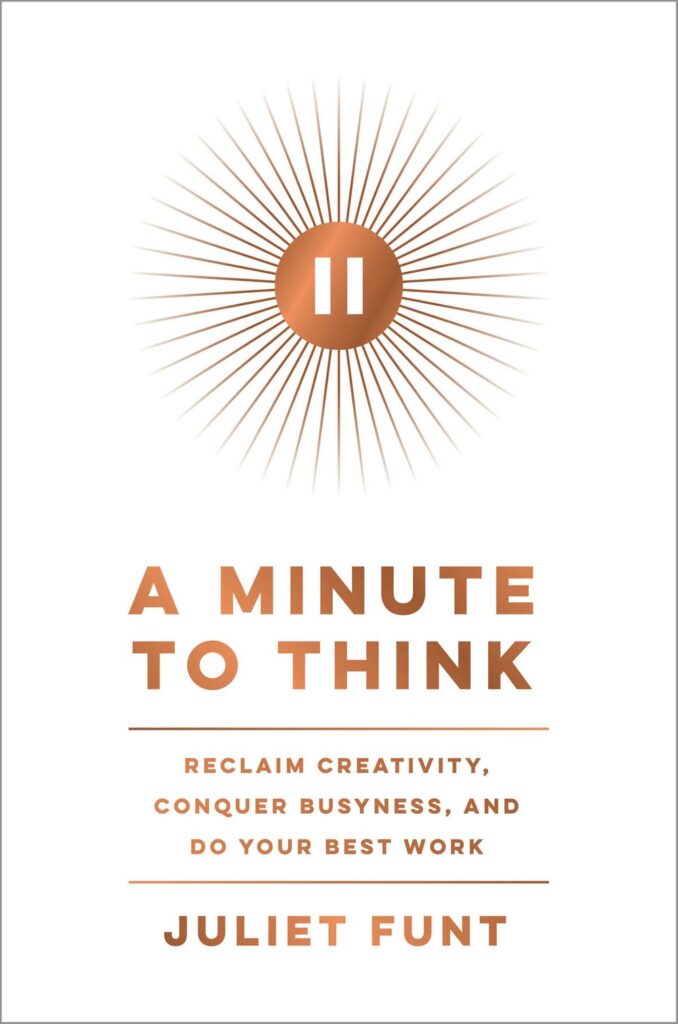Sharing my learnings from the book, A Minute to Think by Juliet Funt
A Minute to Think by Juliet Funt
In A Minute to Think, Juliet Funt, a globally recognized warrior in the battle against busyness, provides a powerful guide that will give you the permission, framework, and specific direction you need to do the following:
- Regain control of your overloaded, caffeinated, inbox-worshiping workday
- Liberate yourself and your teams from burnout and busywork
- Reclaim creativity and focus despite the chaos around you
- Tame the beast of email and escape the mire of meetings
- Find your precious minute to think
With her memorable stories, easy-to-use tools, and razor-sharp instruction, Funt carves for us an escape route from the overwhelm of low-value tasks and the daily avalanche of e-mails, meetings, decks, and reports. Using research, client stories, and a relatable voice, Funt shows all of us how to reclaim time for thinking and make room for what truly matters.

- this is your manual for achieving more by doing less.
- We’re so busy packing our schedules with endless tasks and to-do lists that we can’t fan the flames of our own potential. Instead of thinking, we’re constantly doing. being busy and being productive are not the same thing. What’s more, being too busy can actually kill your productivity.
- Economists call this phenomenon performative busyness. We have internalized the mantra that busier is better. Instead, what we need to do is push back against the tyranny of the packed agenda.
- Our conformity to the cult of overwork can resemble a subtle form of brainwashing, in the sense that our workplaces reprogram us to internalize the upside-down logic of busyness.
- our habit of conforming to the new normal of busyness is not doing us, or our productivity, any favors. the saddest thing of all is that all this stress and burnout are completely unnecessary.
- To complete difficult tasks, you’ll need to engage an area of your brain called the frontal lobe, which carries out your most advanced thinking. But your frontal lobe has a short battery life; it gets tired quickly and needs regular breaks to recharge. This means that if you keep pressing on with your to-do list without taking a break, at some point your frontal lobe will lose efficiency. You’ll no longer be thinking or making decisions to the best of your ability. You need a break.
- The basis of creativity is the neurological connection between our current thoughts and our previous experiences. It can only happen when our brains get free, undisturbed time. In other words, your brain becomes creative when you give yourself time to think.
- four typical types of pauses.
- Type one is the social break – like talking to your coworkers.
- there’s the nutritional break that often involves a snack and maybe a glass of water.
- The relaxation break is time spent daydreaming or doing gentle exercise.
- there are cognition breaks, where you read a book or browse social media.
- the only types of break that boosted productivity were the relaxation and social kinds.
- there are two key motivators in the workplace: we want to achieve excellence and seek out information. these drives are useful but the problem is, in the modern workplace, they’ve gone into overdrive.
- Our drive for excellence can easily tip into perfectionism. perfectionism – that well-known time thief. problems arise when you approach every task like this. After all, time is finite – and so is excellence.
- the desire for information can lead to information overload – and when it does, it also becomes a time thief. The key to stepping back from information overload is to accept that you’re never going to feel like you know enough, no matter how much information you absorb.
- Our thirst for digital communication is disrupting our relationships – and our work.
- Language is among the most powerful tools at our disposal. We use language to express our dreams and define our goals. When we have a disagreement, the way we use language can either heal the rift or deepen the divide. A simple but often forgotten truth is that we can all improve our communication skills by simply thinking before we speak.
- determine the correct amount of time to allocate for meetings. One way is to ask yourself two crucial questions the next time a meeting invite arrives in your email inbox. if the answer to both of those questions is no, then don’t feel guilty about clicking the decline button.
- ask whether you have a unique contribution to make to this meeting. If this is the case, then go ahead and accept the invitation.
- ask whether you would benefit from going to this meeting. If so, then head to the meeting
- When you decline a meeting invite, you can still find a way to get involved. You could send another member of your team in your place, for instance. This will ensure that you receive any necessary updates – and it can be a good way to reward or develop a subordinate who may not have had the opportunity to attend these kinds of meetings before.
- When you treat every decision, request, or email as if it’s time-sensitive, you risk getting into the habit of acting without thinking. The next time you rush to action the moment something hits your inbox, take a pause.


Leave a Reply